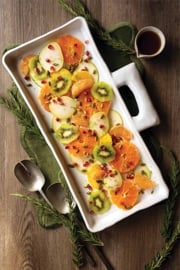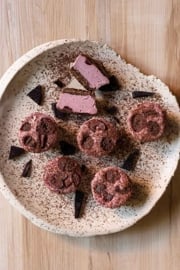Festive Desserts with Flair
As this festive time of year starts to snuggle in close, many often choose to celebrate by indulging in a sweet treat or two. Whether nostalgic, dainty, or decadent, holiday desserts tend to do our bodies no favours, since they’re often full of excess fat, refined sugar, and empty calories.
What draws us to indulge in sugary treats in the first place? Turns out the answer has to do with the reward system in our brains. When we eat something sugary, our brains release a surge of dopamine, a chemical responsible for the feeling of pleasure and reward.
This motivates us to repeat the action that caused the flood of dopamine, reinforcing the reward and causing sugar cravings. To get a sweet fix without getting trapped in a powerful reward cycle, try to enjoy treats that contain a good amount of protein or fibre to slow digestion and help you feel full for longer. Discover our selection of unique and decadent recipes that are sure to bring a festive flourish to the end of any celebratory meal. Not only that, they’ll do so while also helping us keep our health and overall well-being in check. Cheers!
Sweet substitutes
Take a stroll down the baking aisle of a grocery store and there’s a good chance you’ll see a large variety of alternative sweeteners. Here’s a quick guide to some of the most popular natural ones and how best to use them. It’s important to remember, though, that no matter the sugar you use, none are particularly healthy and should all be used in moderation.
Maple syrup
Made from the sap of the sugar maple tree, maple syrup comes in several different grades based on its colour: light, medium, or dark. The darker the syrup, the more robust its flavour and the better it lends itself to either cooking or baking. While maple syrup does contain some nutrients and antioxidants, including manganese, it’s very high in sugar, with a glycemic index just slightly better than that of white sugar.
Agave nectar
This syrupy sugar substitute is made from the sap of the agave plant. While it has a low glycemic index and will not sharply raise blood sugar levels, its fructose content is actually higher than that of white sugar and can wreak havoc on our health if not kept in check. Use agave nectar very sparingly, or source out another alternative sugar to use in cooking and baking.
Brown rice syrup
A light brown, thick, and sugary syrup derived from brown rice, this sweetener is made up of 100 percent glucose and is a popular choice for those avoiding fructose. It does, however, have a very high glycemic index, which causes blood sugar and insulin levels to rise rapidly then crash, causing feelings of hunger and cravings.
Yacon syrup
Derived from the yacon tuber grown in the Andes of Peru, this thick, caramel-flavoured syrup can be used as a garnish. It contains fructooligosaccharides, a type of fructan, which are not fully digested by the body and act as soluble fibre. Take note that yacon syrup is best used in applications that aren’t heated, as high temperatures will break down the fructooligosaccharides.
Stevia
Stevia is a plant whose leaves have a sweet taste. The stevia found on most grocery shelves, though, is a highly refined stevia leaf extract called rebaudioside A or Reb-A, which is often blended with other alternative sweeteners. Reb-A is a non-nutritive sweetener, meaning that it contains almost no calories, and at nearly 200 times sweeter than white sugar, a little can go a long way.
Coconut sugar
Derived from the sap of the coconut palm tree, coconut sugar is a granulated, sandy-textured sugar with a taste like brown sugar. Coconut sugar does contain very small amounts of some nutrients and has a lower glycemic index, thanks to its content of inulin, a type of soluble fibre that slows absorption of food in our gut. It is, however, high in fructose and high in calories, and its overall health effects are largely similar to those of white sugar.
Date sugar
Date sugar is made from dehydrated dates that have been ground up. It resembles brown sugar and has a pleasant butterscotch-like flavour. Since it is the ground-up fruit, it retains all the dates’ vitamins, minerals, antioxidants, and fibre. Thanks to its fibre content, it has a relatively low glycemic index. Take note that date sugar doesn’t dissolve in hot liquids or with cooking and may not be what you’re looking for as a substitute for sugar in a recipe.
Monk fruit powder
This powdery sugar substitute is made from the dehydrated juice of monk fruit, or luo han guo, grown in Southeast Asia. While it does contain sugars, mainly fructose and glucose, monk fruit powder is calorie free and is 100 to 250 times sweeter than white sugar, due to a unique antioxidant called mogrosides. You’re most likely to find it on grocery shelves mixed with another alternative sweetener to tame its intense sweetness.
Erythritol
Erythritol is a low-calorie, plant-based sugar alternative belonging to a class of compounds known as sugar alcohols. Human beings lack the enzymes needed to break down erythritol, so it doesn’t change blood sugar or insulin levels when eaten. Studies have shown erythritol to be a safe sweetener, and it’s also been credited with beneficial effects on oral health due to its ability to slow the growth of bacteria and decrease the acid the bacteria make.
Xylitol
Like erythritol, xylitol is a sugar alcohol. It’s plant based, has a very low glycemic index, and has 40 percent fewer calories than white sugar. While it may cause some digestive discomfort in some, xylitol has been shown to possess similar oral health benefits to erythritol, while also helping to increase collagen production.








